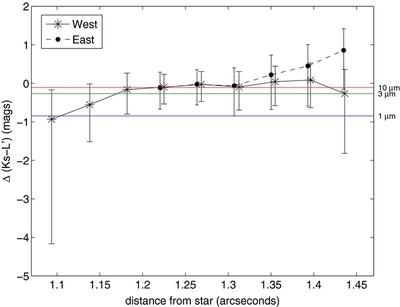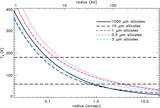Image Details

Caption: Figure 8.
Disk color vs. distance from the star, expressed as Δ( Ks − L′) = ( Ks − L′) Disk −( Ks − L′) Star. This is calculated only where the disk is detected at both the Ks band and at L′. To constrain dust grain size, we also plot model colors from Inoue et al. (2008) (colored horizontal lines). The data suggest that the eastern side of the disk becomes redder than the western side with increasing distance from the star. 1–10 μm grains are the best fit to the western side, while 3–10 μm grains are the best match to eastern side. This may suggest that the west side of the disk is composed of smaller grains than the east side.
Copyright and Terms & Conditions
© 2012. The American Astronomical Society. All rights reserved.












